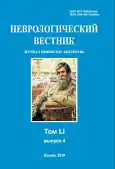Assessment of the pharmacotherapy influence on mental state deterioration in acute endogenous psychosis
- Authors: Veraksa A.E.1,2,3, Egorov A.Y.1,4,5
-
Affiliations:
- I.M. Sechenov Institute of Evolutionary Physiology and Biochemistry of the Russian Academy of Sciences
- St. Petersburg State Public Health Institution "St. Nicholas Psychiatric Hospital"
- Saint-Petersburg State Pediatric Medical University
- St. Petersburg State University, Medical Faculty, Department of Psychiatry and Addictions
- I.I. Mechnikov Nord-West State Medical University
- Issue: Vol LI, No 4 (2019)
- Pages: 92-94
- Section: Recommendation for practitioners
- URL: https://journals.rcsi.science/1027-4898/article/view/16424
- DOI: https://doi.org/10.17816/nb16424
- ID: 16424
Cite item
Full Text
Abstract
Due to the diagnostic difficulties and the lack of clinical recommendations for treatment, assistance in acute endogenous psychoses (atypical, cycloid psychoses) is a hard task in psychiatric practice. The abundance of different therapeutic approaches has not yet been systematically investigated. The data obtained suggest that benzodiazepine monotherapy is the most effective and safe method, while other pharmacological combinations have significant drawbacks and can provoke deterioration of the mental state and the resumption of psychosis. Risk factors for the recurrence of psychosis include the use of antipsychotics in high doses, the combination of several antipsychotics and the addition of cholinolytic drugs to therapy.
Full Text
##article.viewOnOriginalSite##About the authors
Anastasiya E. Veraksa
I.M. Sechenov Institute of Evolutionary Physiology and Biochemistry of the Russian Academy of Sciences; St. Petersburg State Public Health Institution "St. Nicholas Psychiatric Hospital"; Saint-Petersburg State Pediatric Medical University
Author for correspondence.
Email: cae08@inbox.ru
Junior Researcher; psychotherapist; assistant
Russian Federation, 194223, St. Petersburg, Torez prospect, 44; 190121, Saint-Petersburg, nab. r. Moyki, d.126; 194100, Saint-Peterburg, Litovskay street, d. 2Aleksej Yu. Egorov
I.M. Sechenov Institute of Evolutionary Physiology and Biochemistry of the Russian Academy of Sciences; St. Petersburg State University, Medical Faculty, Department of Psychiatry and Addictions; I.I. Mechnikov Nord-West State Medical University
Email: draegorov@mail.ru
head of laboratory; professor Department of Psychiatry and Addictions
Russian Federation, 194223, St. Petersburg, Torez prospect, 44; 199034, St. Petersburg, University embankment, 7-9; 191015, St. Petersburg, Kirochnaya Street, 41References
- Harima H. Diagnosis and treatment of “acute psychosis” from the dimensional perspective. Seishin Shinkeigaku Zasshi. 2011; 113: 1235–1240.
- Garcia-Andrade R.F., Diaz-Marsa M., Carrasco J.L. et al. Diagnostic features of the cycloid psychoses in a first psychotic episode sample. J. Affect Disord. 2011; 130: 239–244.
- Sakamoto K. Categorical and dimensional diagnostic approach to acute psychosis in view of operational diagnostic criteria. Seishin Shinkeigaku Zasshi. 2011; 113 (12): 1228–1234.
- Derito M., Martínez-Rodríguez G., Monchablon-Espinoza A. Las Psicosis Cicloides: Psicosis Bipolares no Maníaco-depresivas. Alcmeón. 2005; 47: 271–299.
- García-Andrade R.F., López-Ibor J.J. Acute treatment of cycloid psychosis: study on a sample of naive hospitalized patients with first-episode psychosis (FEP). Actas. Esp. Psiquiatr. 2015; 43 (2): 51–57.
- Веракса А.Е., Егоров А.Ю. Сравнение стратегий купирования острых эндогенных психозов. Неврологич. вестн. 2016; XLVIII (1): 36–41. [Veraksa A.E., Egorov A.Yu. Comparison of acute endogenous psychosis management strategies. Nevrologicheskiy vestnik. 2016; XLVIII (1): 36–41. (In Russ.)]
- Sienaert P., Dhossche D.M., Vancampfort D. et al. A clinical review of the treatment of catatonia. Front. Psychiatry. 2014; 5: 181. doi: 10.3389/fpsyt.2014.00181.
- Sundararajan Rajagopal. Catatonia. Adv. Psychiatr. Treat. 2007; 13: 51–59.
Supplementary files






